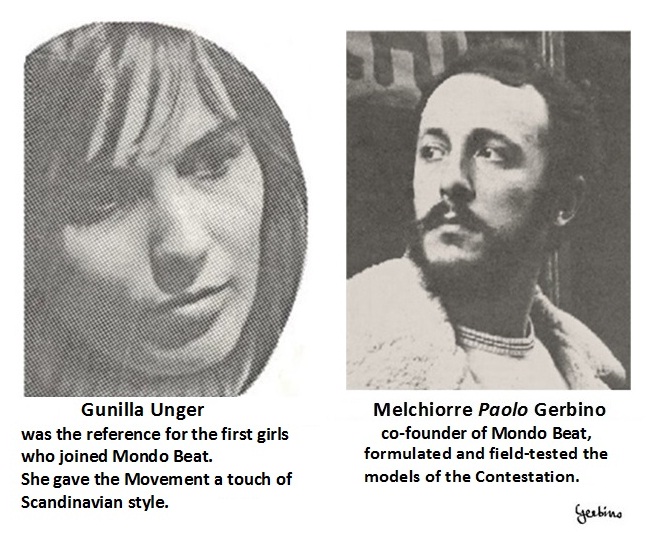
Gunilla Unger was the reference for the first girls who joined Mondo Beat. She gave the Movement a touch of Scandinavian style.
Melchiorre Gerbino formulated and field-tested the models of the Contestation.
It is worth describing the situations created by the opening of the Cave because, due to this event, the Mondo Beat Movement expanded, as the Cave became an important point of reference for young Italians on the road and for those European youths who participated in the Movement since the days of the Flood in Florence.
An increasing number of youths would have frequented the Cave, as they could stay there at will and could keep there their belongings for free and for an indefinite period. Furthermore, the full participation of girls, and many of them, in the headquarter of a movement of counterculture, would have been a relevant phenomenon, because unprecedented before Mondo Beat era.
Even sgrumpy and lonely youths would have felt comfortable in the Cave, as no one would have asked them to stick to some kind of schedule. In the Cave, in fact, there was no hierarchy, but people who carried out functions (Umberto Tiboni the management of the premises; Melchiorre Gerbino the editorship of Mondo Beat magazine; Giorgio Contini the direction of the cellar and the wardrobe) but none of them had the status to order others to do this or that. Such an unprecedented situation made the Cave a mythical place and would somehow have improved the personal behavior of those who attended, as everyone would have felt a moral duty to behave honorably.
Furthermore, since the Cave was infiltrated by secret agents and police informants, and all the youths who frequented the Cave knew about it, this situation would have created the participation of courageous young people. Mondo Beat did not want to promote any kind of illegal actions, so it had nothing to hide, on the contrary, it wanted to affirm what the Italian Constitution guaranteed in words and the Establishment prevented in deeds. Thus, in the Cave a selection of heroic young people would have participated, who would have openly confronted the Establishment to affirm civil rights, while the coward young people, those who followed Buddhist and Beat Generation fashions to justify their submission, would not have participated.
As for the Vatican (when I say "the Vatican", I mean to summarize in two words the reality of political power in Italy) being more and more concerned by the expansion of the Mondo Beat Movement, the Vatican had ordered its repression. Thus, to carry out this task, the Italian Prime Minister, Aldo Moro, activated the police headquarters of the main Italian cities which would issue a deluge of compulsory expulsion orders against the Beats. But no Beat would have died because of this, instead the Movement would have expanded further, because there were Beats who went to small towns to take refuge from police injunctions, so the Movement would have also infected the small towns of Italy.
Now, returning to the chronological reconstruction of the history of the Mondo Beat Movement, on 16 February 1967, Umberto Tiboni had located a printing house near the Cave, Tecnografica Milanese, which would print an issue of the magazine Mondo Beat at a favorable price, on condition that Mondo Beat had paid the cost upfront.
We had some money from the sale of the second issue of the magazine, but it wasn't enough, so Umberto Tiboni, Gunilla Unger and Melchiorre Gerbino had to donate their money again. But from then on Mondo Beat would have to be self-sufficient and the money could only come from the sale of the magazine. We thought we could do it, given that the Movement had expanded greatly with the opening of the Cave, so on the same day Umberto Tiboni and Melchiorre Gerbino delivered Tecnografica Milanese the money for an issue of four thousand copies, the first fully authorized Mondo Beat issue, completely printed in letterpress.
As for the content of this issue, Melchiorre Gerbino would not have hesitated to attack the establishment. As we will see, he would have reproduced on the front page a collage of mandatory expulsion orders that various police headquarters had imposed on youths of the Mondo Beat Movement.
But on February 18, that is, two days after we had given the money to Tecnografica Milanese, and before Tecnografica Milanese had finished the printing work, the Cave was besieged by a large number of plainclothes agents.
Perhaps the Police Headquarters was ordered to paralyze the Movement before this issue would be distributed. Or it was a coincidence that Mondo Beat was on the verge of attacking the establishment with its magazine, when the police were already on the verge of intervening to paralyze the Movement. In any case, two days after we had handed over the money to Tecnografica Milanese, the Cave was besieged by a large number of plainclothes police. We did not expect such an action against us, given that the Cave was the official headquarters of a regularly registered magazine.
And now it was easy for the policemen positioned in the streets near the Cave to intercept Beats who did not have registered residence in Milan, so we were decimated by mandatory expulsion orders. And this practice of mandatory expulsion orders had become customary not only in Milan, but in all cities where the Movement had expanded, Turin, Genoa, Padua, Trento, Bologna, Florence, Rome... Thus, the young people who had been ordered not to stay in Milan would have left the Cave, while others, who had been ordered not to stay in other cities, would have converged on Milan and towards the Cave and among them were young people expelled from three, four, five cities.
As already mentioned, in the mandatory expulsion orders issued against the Beats, it was written in block letters SI CONTESTA (It is notified) followed by the terms of the injunction. And this SI CONTESTA obsessed us, so much so that at a certain point, to the old lady with the doggie who asked him "Why do you protest?" Gerbino would have replied, paraphrasing the terminology of police injunctions "No, madam, I do not protest, I contestate". And from then on, he would have substituted the verb "protest" with the newly formulated verb "contestate", and instead of saying "This is a protest", he would have said "This is a contestation". And he would have formulated neologisms in expressions as "I am a contestator" and "This is a contestatory attitude". And this new terminology would have spread successfully because people would have realized that at Mondo Beat we were engaged in something more radical than protesting. Immediately after Italian, this terminology would have spread into French, like the Contestation itself, and from there throughout the world.
Such had been Melchiorre Gerbino's despair because of this SI CONTESTA that his reaction would have had a worldwide success. But not immediately, because on 24 February 1967, when Tecnografica Milanese came to deliver the 4,000 copies of the new issue of the magazine, Mondo Beat was under siege and in danger of extinction.
Mondo Beat N. 1 (Issue 3)
- March 1, 1967 - Edition: 4,000 copies
Note. With the exception of the cliché on the cover, which was prepared in the Cave, all the other clichés with which Melchiorre Gerbino structured this issue were kindly provided to Mondo Beat by L'Unità, the official newspaper of the Italian Communist Party. These clichés had already been printed by L'Unità and were piled in bulk in a box, from which Gerbino could take at will thanks to Giorgio Manzini, a journalist from L'Unità who had previously interviewed him. As we will see, the magazine Mondo Beat will always maintain a well-defined distance from communist (as well as fascist) political positions but L'Unità would always have had the fair play to allow Gerbino to take from the old clichés as he pleased.
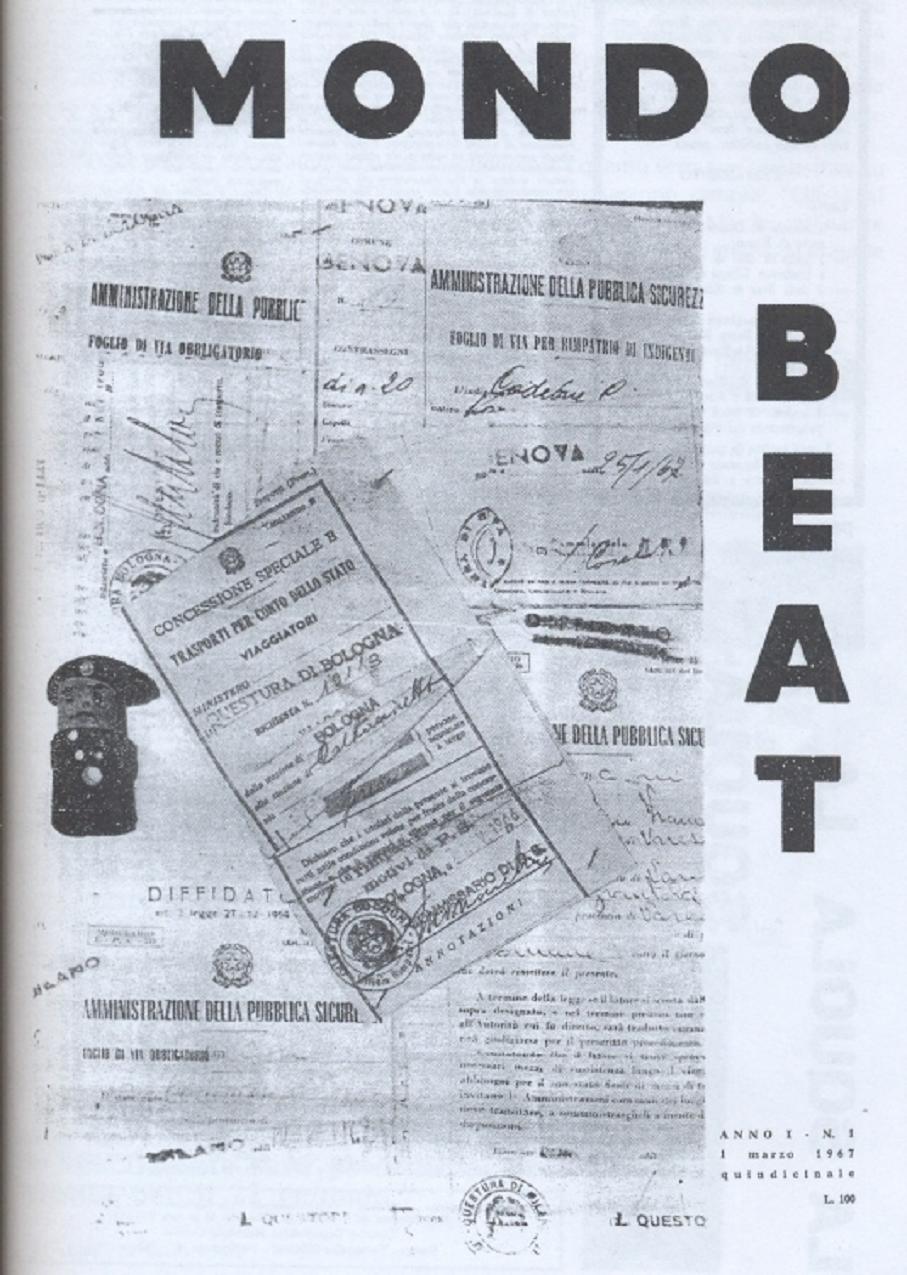
Mondo Beat N. 1 - page 1 - March 1, 1967.
This cover, composed by Melchiorre Gerbino with coercive expulsion orders issued by various Italian Police Headquarters against the Beats, has a historical significance, as it marks the moment of the birth of the Contestation, that is, the moment from which the Mondo Beat Movement openly confronted the establishment due to these illegal injunctions.
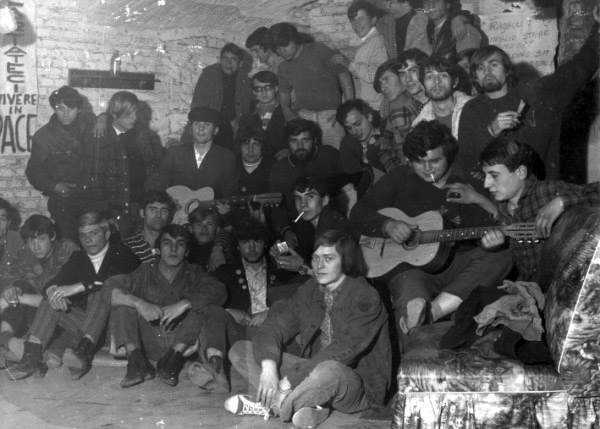
Youths from the "Base of Mondo Beat" in late February 1967.
The young people who did not live in the family, did not attend school, refused wage work, carried out the "contestazione globale" (total contestation) and formed the "Base di Mondo Beat" (Base of Mondo Beat). The Base was international, the vast majority of the youths were Italian, then the most numerous were French. The youths of the Base were around 400, but when they gathered for collective actions they never exceeded 200, the others were on travel or in prison. The Base was constantly decimated by the police, but also constantly revitalized by the arrival of new young people.

Some popular youths from the Base of Mondo Beat.
Reproduction of the other pages of this issue:
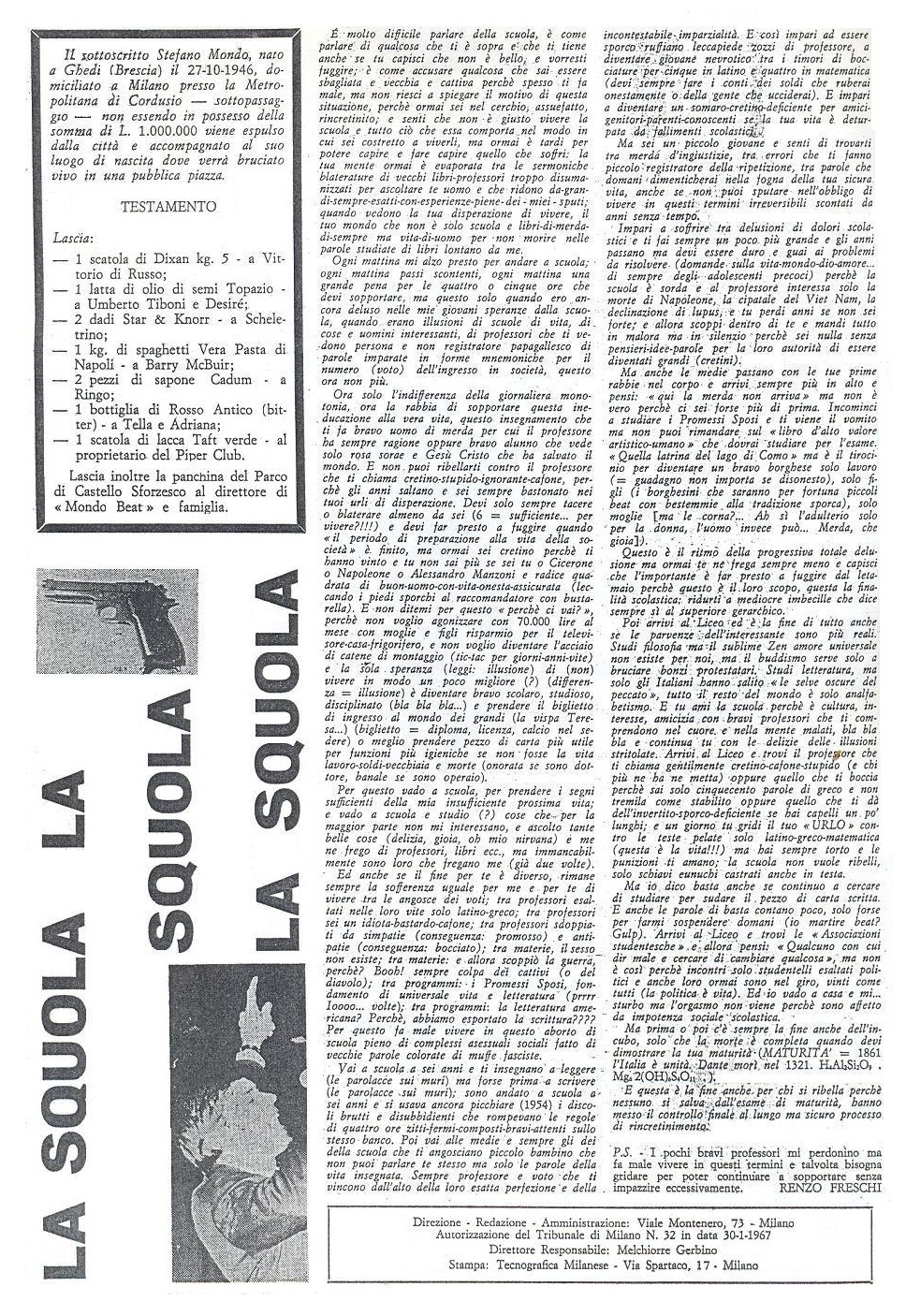
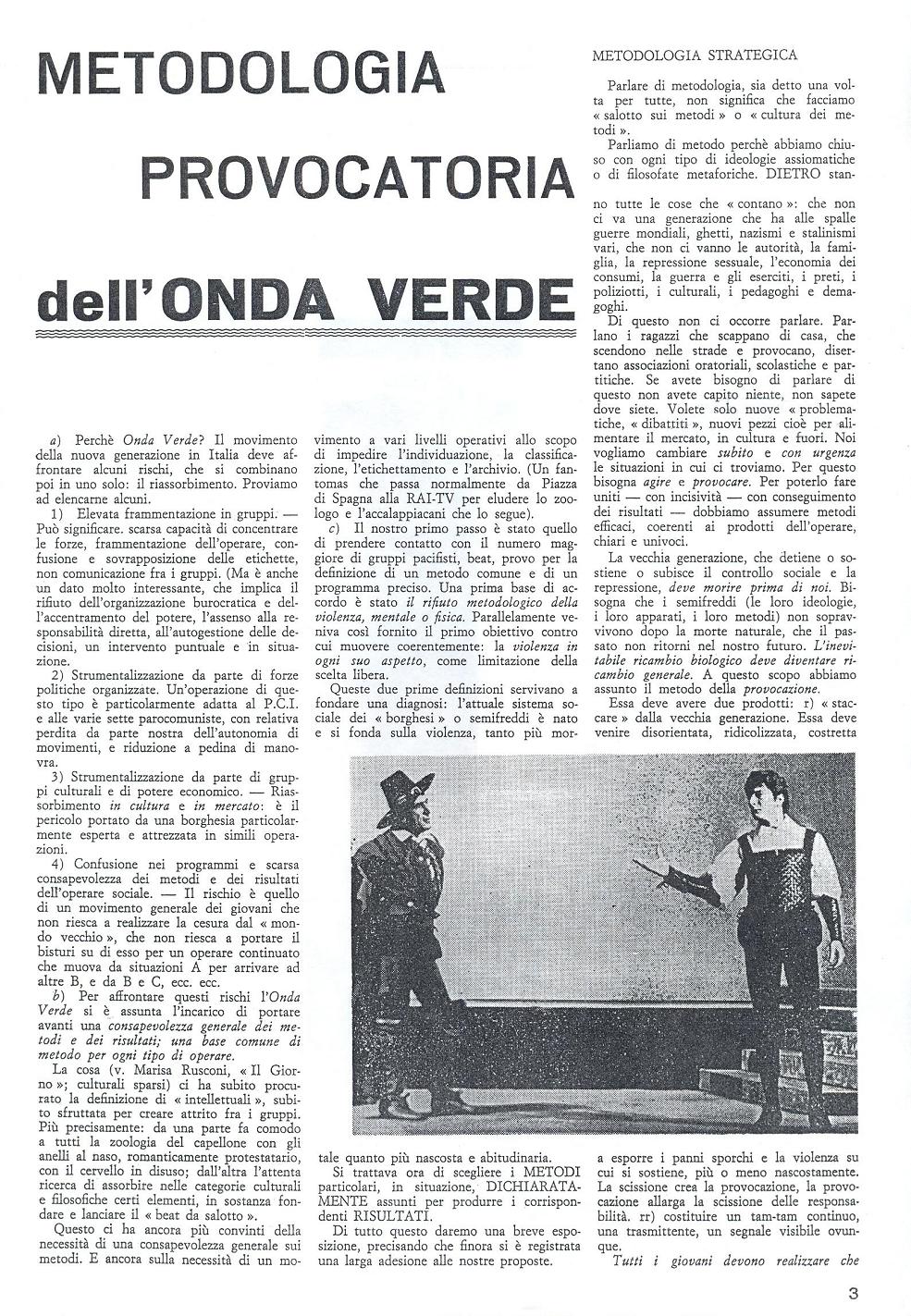
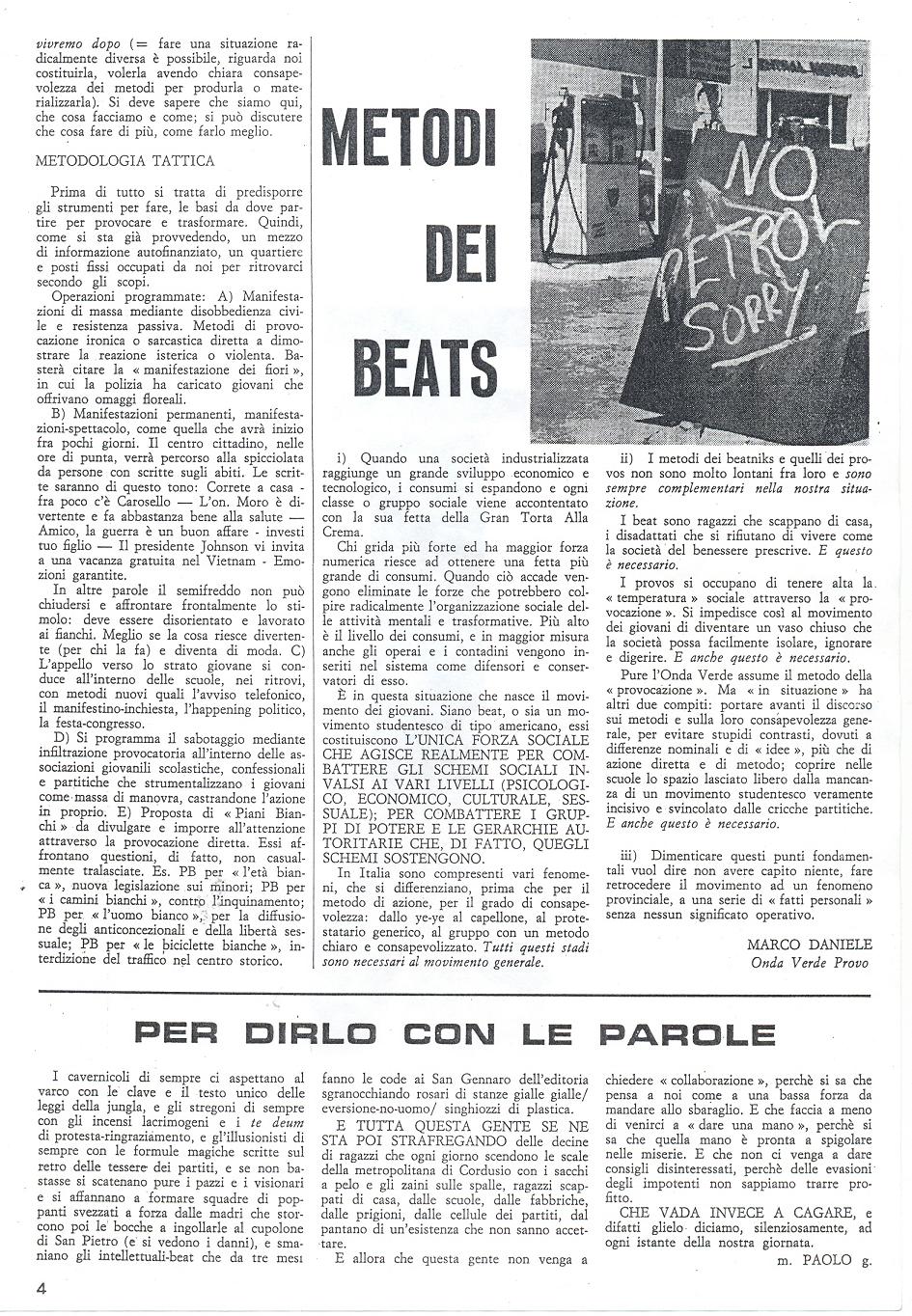
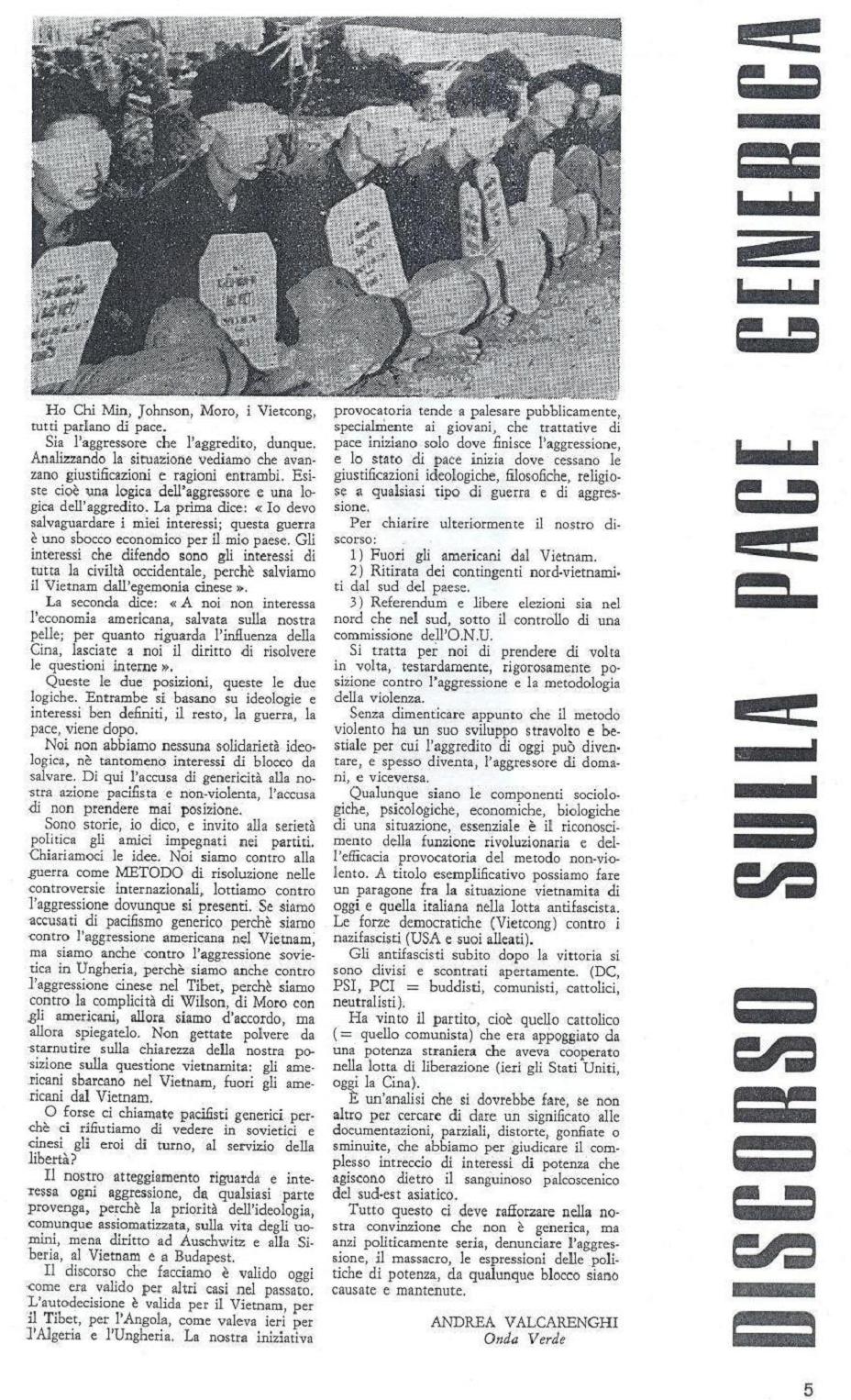
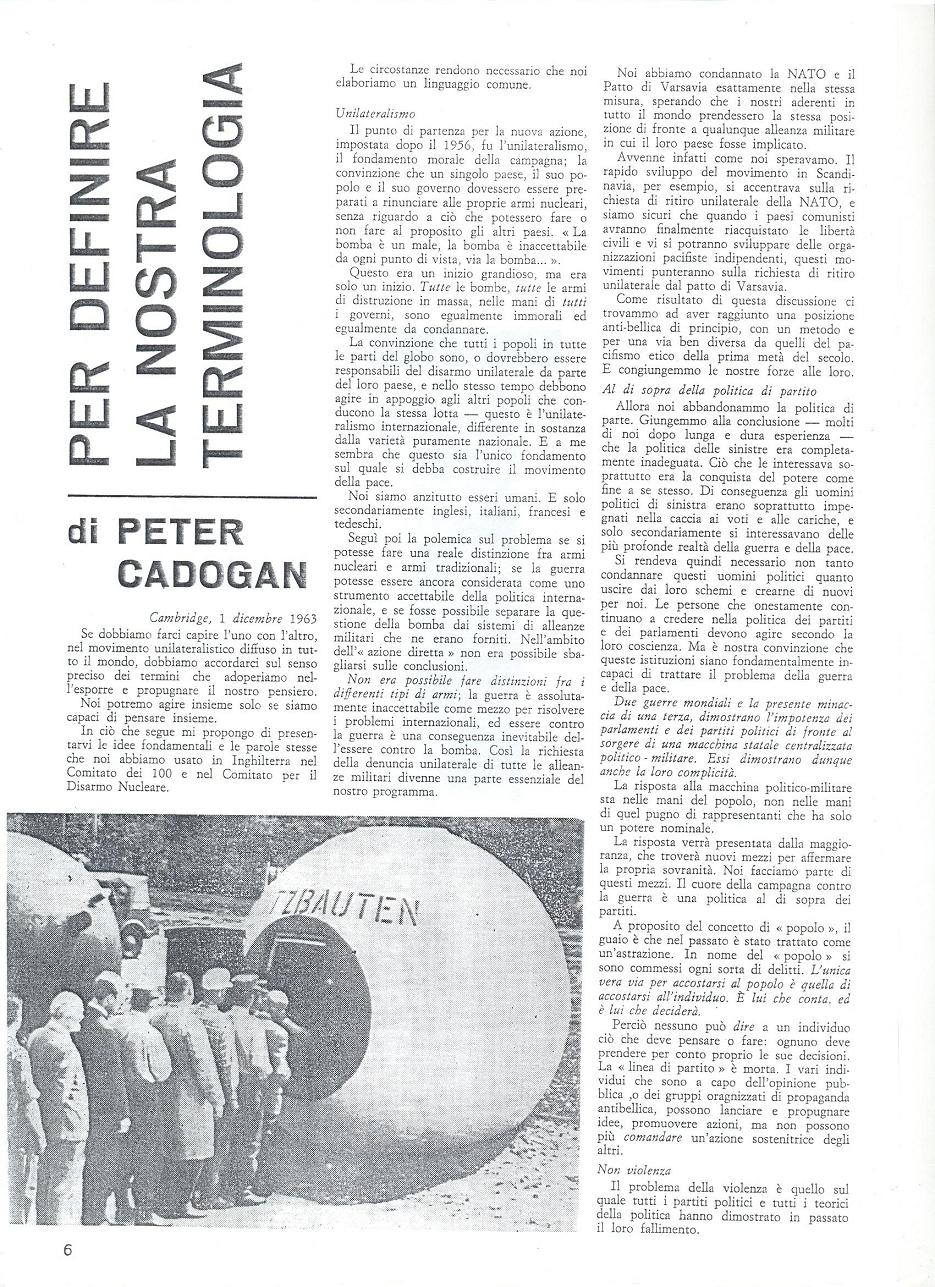
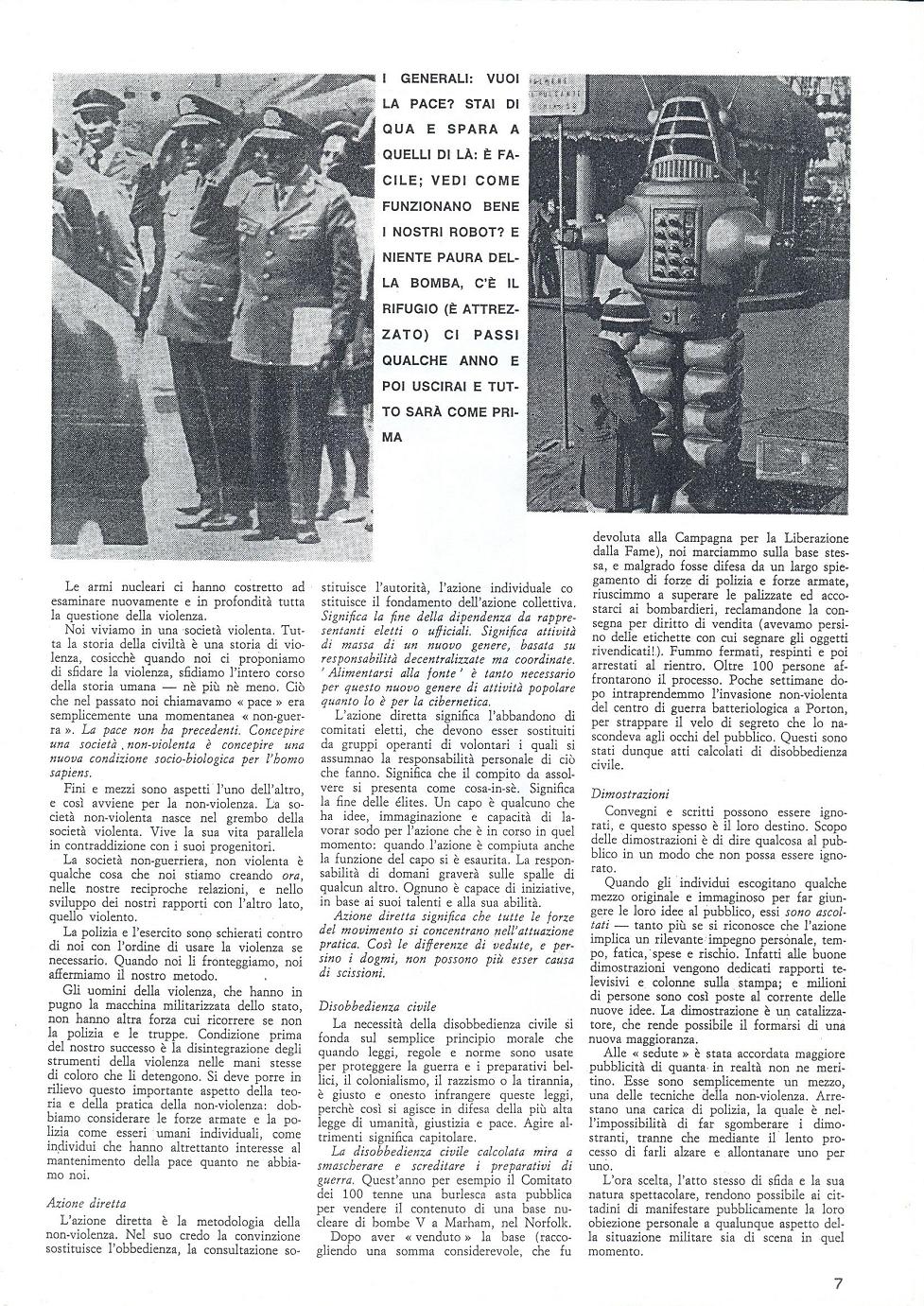
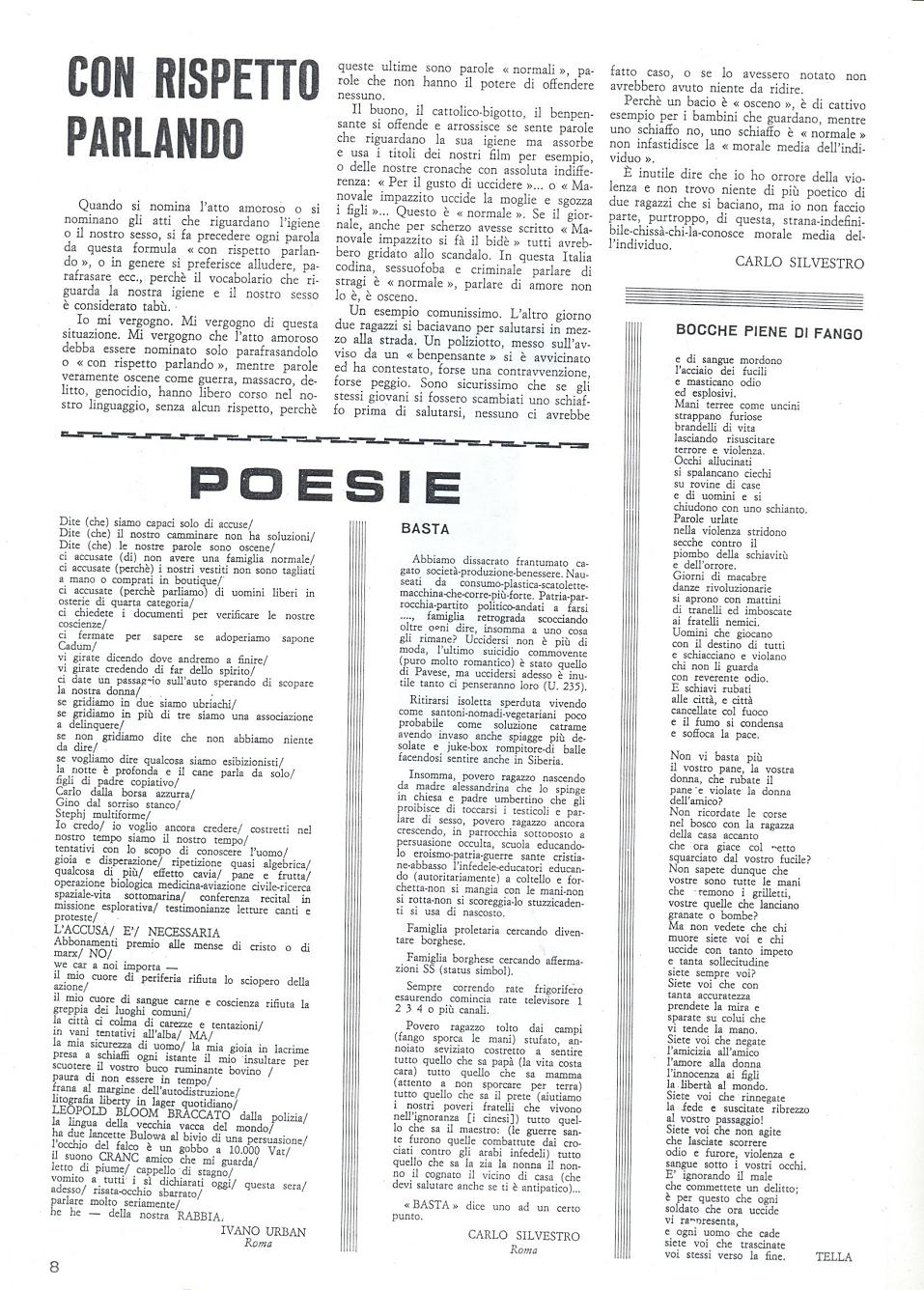
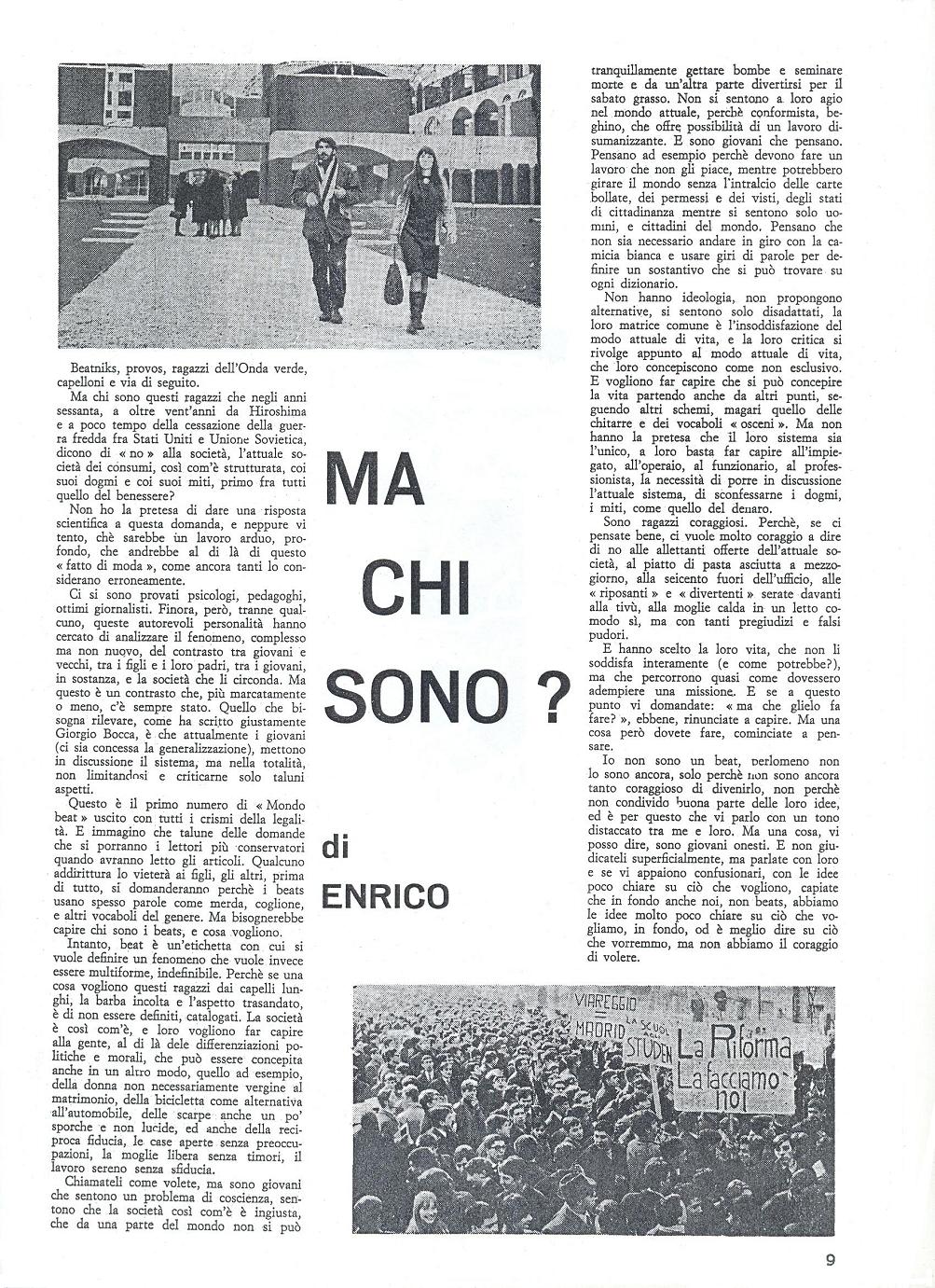
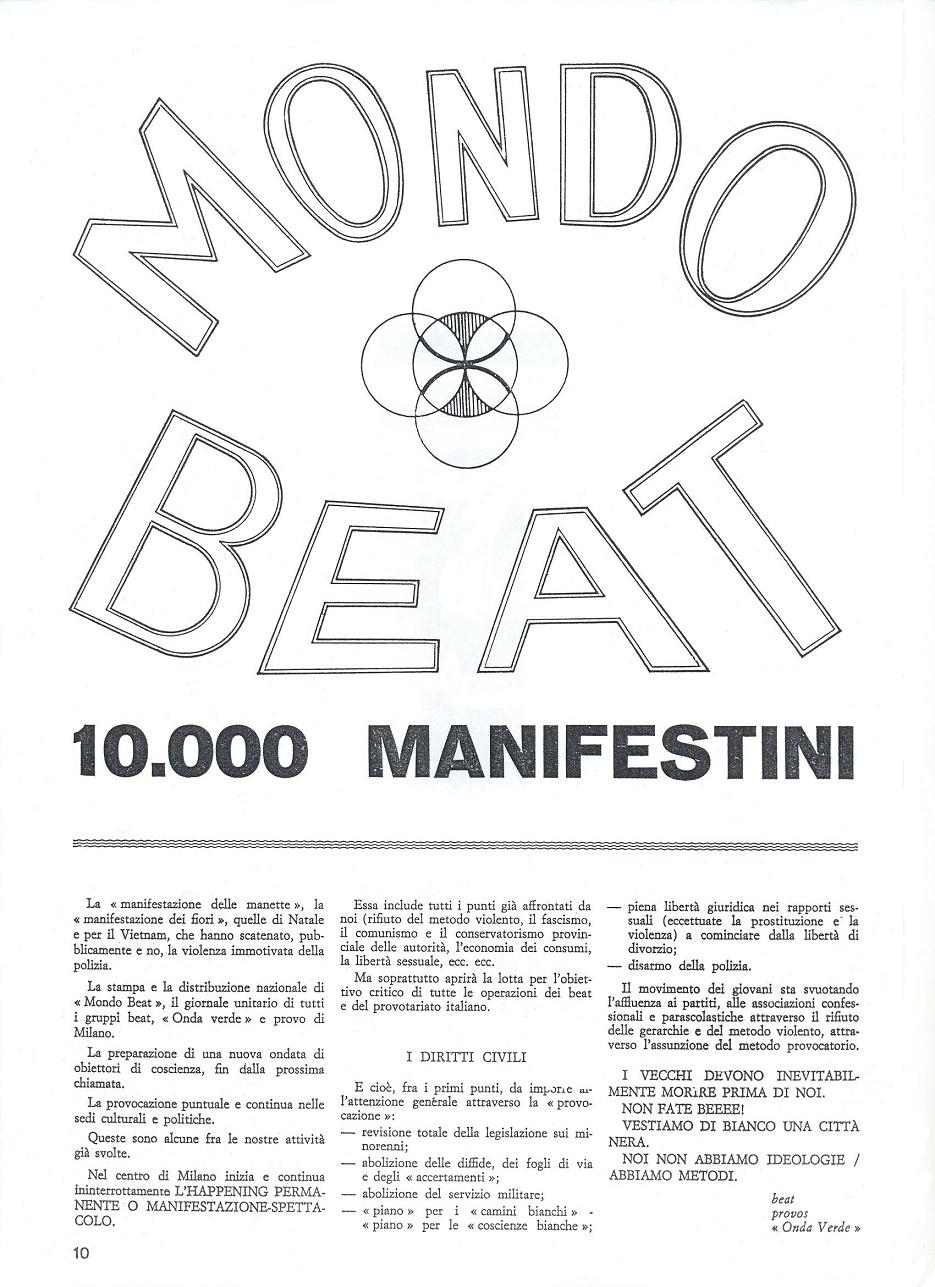
Comments on articles.
page 2
"La Squola" by Renzo Freschi.
After reading the articles by Marco Maria Sigiani and Antonio Pilati, published in the previous issue, Renzo Freschi finally understood that in his situation it was reasonable to write about the condition that he himself experienced and suffered as an Italian student, rather than copying what Fernanda Pivano, the CIA agent, wrote about the Beat Generation. So Renzo Freschi wrote an article on the Italian school, an appreciable article, because it was written with a sincere outburst of irony and anger. He voluntarily titled this article with an incorrect spelling, as the correct spelling would have been "La Scuola" and not "La Squola" as he wrote.
In this article the prosecutor Antonio Scopelliti found a pretext to order the seizure of the issue and indict Renzo Freschi, author of the article, and Melchiorre Gerbino, director of the magazine, for "contents contrary to morality."
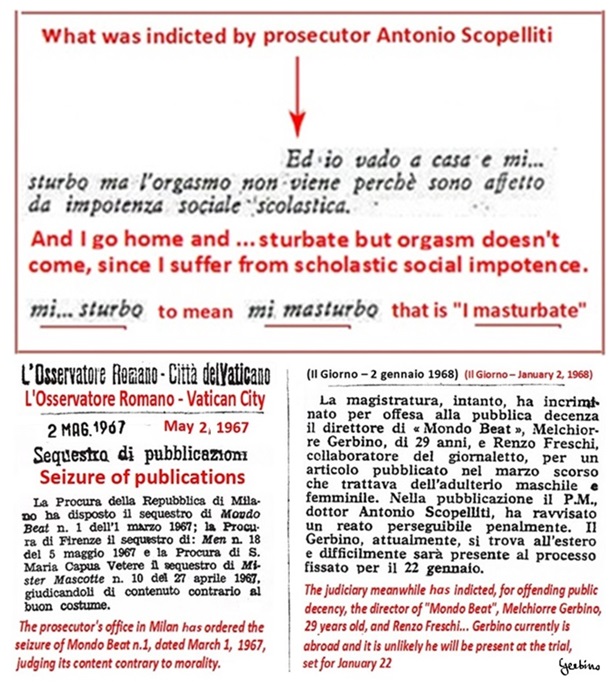
Incrimination of Mondo Beat N. 1 - Seizure - Trial.
Above is the passage from Renzo Freschi's article which, according to prosecutor Antonio Scopelliti, justified the seizure of this issue of Mondo Beat.
There is also the reproduction of a short article from L'Osservatore Romano, the official Vatican newspaper, who did not miss the opportunity to inform its readers that an issue of the magazine Mondo Beat had been seized because its content was contrary to morality. And there is an excerpt from an article from Il Giorno about the trial that would have followed.
But in reality the incrimination of Renzo Freschi's article was a pretext to order the seizure of this issue whose cover was a collage of mandatory expulsion orders against the Beats. These expulsion measures were unconstitutional as they prevented citizens who had not committed any crime from staying in areas of the national territory. The police imposed these injunctions by virtue of a public security code issued in the fascist era (Codice Rocco), which was still used by the post-fascist Italian regime, which claimed to be democratic.
However, due to the slowness of the Italian system at the time, the agents arrived at the Cave to seize the copies two months after they had already sold out. And Melchiorre Gerbino and Renzo Freschi would have been acquitted at the trial, as "the fact did not constitute a crime".
As for the public prosecutor Antonio Scopelliti, at a certain point in his career he was killed in an ambush in Calabria, his native region, and certainly not because of the seizure of an issue of the Mondo Beat magazine. The fact is that some judges and police commissioners, who may be suspected of being in the service of the Vatican, are mysteriously killed at some point in their careers. By order of the Vatican itself? With the aim of turning the pages of heavy judicial events by eliminating some protagonists? If this were the case, there is no risk for the Vatican, because the Italian media are ready to shout: "The Mafia! The Mafia!".
On the same page 2, "Testamento" (Last will and testament). A joking writing by Stefano Mondo, who was leaving Milan due to a mandatory expulsion order he had received. Here is the translation of part of it:
The undersigned Stefano Mondo, born on 27 October 1946 in Ghedi (Brescia), domiciled in Milan in the underpasses of the Cordusio metro station - not being in possession of the sum of one million lire, is expelled from the city and taken to the place of birth, where he will be burned alive in a public square.
LAST WILL AND TESTAMENT
He donates: and here was listed what he donated. Among the donations were 2 Star & Knorr cubes to Scheletrino, a stunted boy nicknamed Thin Skeleton; 2 pieces of Cadum soap to Ringo, a boy who desperately needed it ; 1 bottle of Rosso Antico Amaro (a so called 'bitter wine') to Tella and Adriana, a bitter wine because the two girls had refused to make love with him.
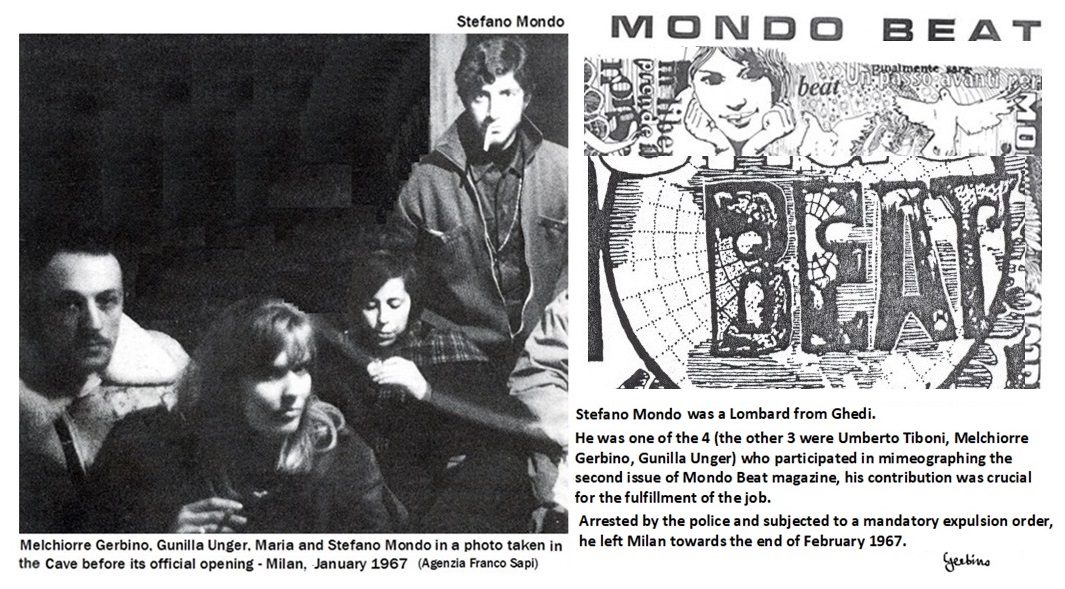
Melchiorre Gerbino, Gunilla Unger, Maria and Stefano Mondo in the Cave.
Stefano Mondo was a Lombard from Ghedi. He was one of the four who contributed to the printing of the second issue of Mondo Beat magazine (the other three were Gunilla Unger, Umberto Tiboni, Melchiorre Gerbino). Stefano Mondo's contribution was important for the fulfillment of the work.
page 3
"Metodologia provocatoria dell'Onda Verde" (The provocative methodology of Onda Verde) by Marco Daniele from the Onda Verde group, who analyzed the provocative methodology of the Dutch Provos, adopted by all European Provos as they were all inspired by the Dutch ones.
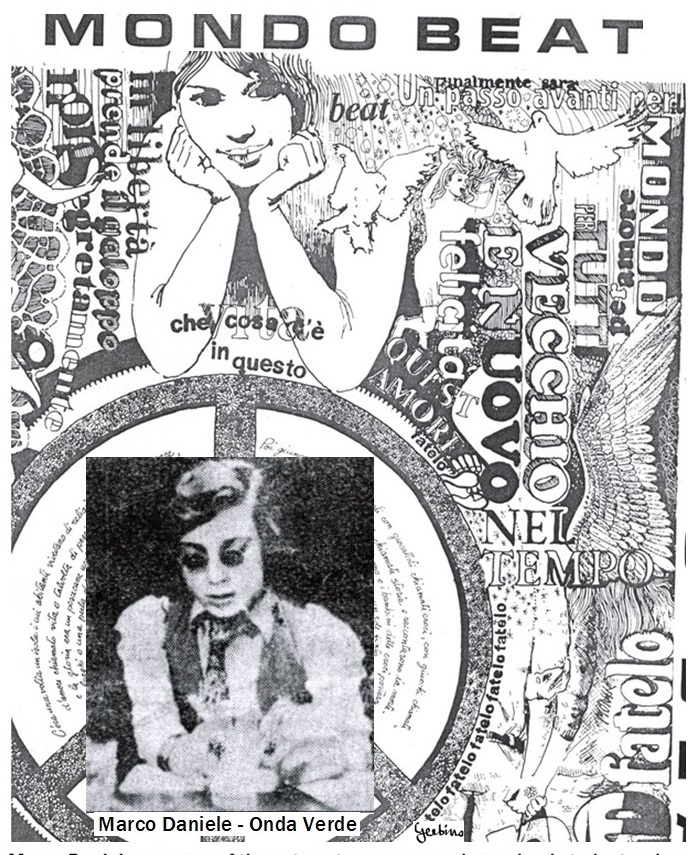
Marco Daniele - Onda Verde.
page 4
"Metodi dei Beats" (Methods of the Beats) by Marco Daniele, who underlined how the different characteristics of Beats, Provos and Ondaverdes were complementary to give impulse to the Mondo Beat Movement.
On the same page 4, "Per dirlo con le parole" (To put it in words) by Paolo (Melchiorre Paolo Gerbino).
It was a harsh comment from Melchiorre Gerbino, who wanted to get rid of some people who did not actively participate in the Movement but wanted to publish their articles in the magazine, their articles being those of people who did not realize what was happening with the Contestation, because they were strangers to it.
page 5
"Discorso sulla pace generica" (Discussion on generic peace) by Andrea Valcarenghi.
What Andrea Valcarenghi wrote in this article is not interesting because there is nothing original. We should instead talk about Valcarenghi himself, because he was trapped by the Italian secret services and ended up under their orders. We will talk about this regrettable situation in more detail later.
Below is a photo taken on 8 April 1967, on the occasion of a demonstration of the Mondo Beat Movement. Under the sign CHIEDIAMO I DIRITTI CIVILI (WE ASK FOR CIVIL RIGHTS) there are Melchiorre Gerbino and Andrea Valcarenghi (with glasses). At the time, Melchiorre Gerbino could not foresee that Andrea Valcarenghi would end up under the orders of the Italian secret services and allowed him to stay at his side.
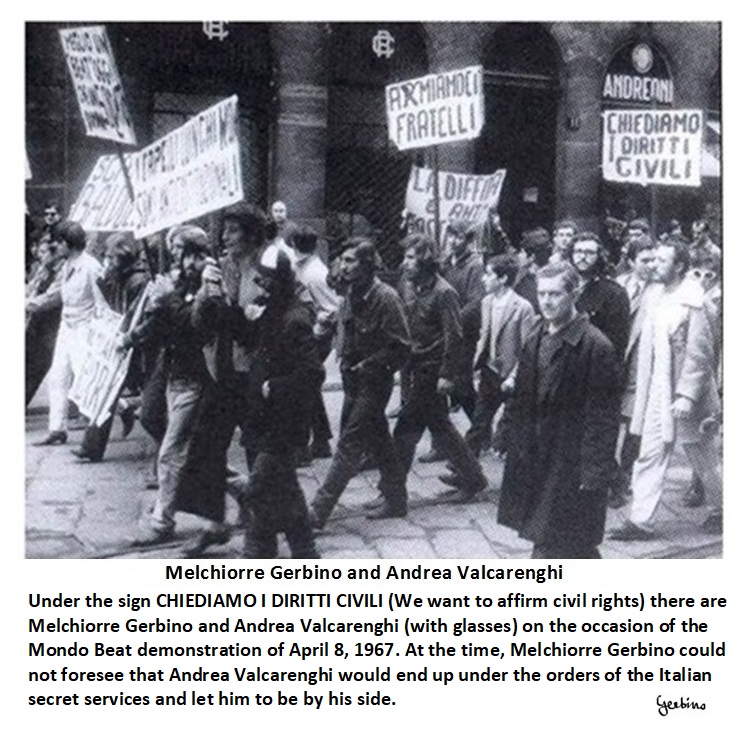
Melchiorre Gerbino and Andrea Valcarenghi on the occasion of a demonstration of the Mondo Beat Movement. Milan, 8 April 1967.
page 6
"Per definire la nostra terminologia" (To define our terminology) by Peter Cadogan.
Peter Cadogan was much appreciated by the guys at Onda Verde, who translated this essay from English into Italian.
page 7
Continuation of "Per definire la nostra terminologia" (To define our terminology) by Peter Cadogan.
Peter Cadogan was admired for his reluctance towards all types of established organizations.
page 8
Three poems, respectively by Tella (Ferrari), Ivano Urban and Carlo Silvestro and, by the latter, an article on how in common language the most atrocious facts are described without any linguistic effort (the killing of his wife and 4 children) when writing about sex the words must somehow be supported by circumlocutions and premises. Carlo Silvestro was a Roman photographer who periodically came to Milan, attracted by the eye of the storm of the Contestation. Taking a cue from him, I want to say a few words about Rome and Milan at the time of the youth uprising in Italy. Some impostors, sponsored by the Vatican to trivialize the history of the youth uprising in Italy, tell that the Italian movement was born and was influenced by foreign longhairs who spent time in the Scalinata della Trinità dei Monti in Rome. But, if that were the case, the Movement would have been born in Rome and not in Milan. But at the time of the Movement, almost nothing happened in Rome. But at the time of the Mondo Beat Movement almost nothing happened in Rome. This is the reason why Carlo Silvestro came to Milan. In fact, the most numerous young people of the Mondo Beat Movement, after the Milanese, were the Romans who, bored of doing nothing in Rome, came to Milan (like Eros Alesi, for example). In reality the seeds of the Italian movement did not come from the Scalinata della Trinità of the Mountains of Rome, but from the cellars of Gamla Stan, the Old Town of Stockholm, where Gunilla Unger and Melchiorre Gerbino met Vittorio Di Russo, and where they spent years of their youth, when that milieu was the best frequented internationally and the most sexually liberated.
page 9
'Ma chi sono?' (But who are they?) by Enrico on the Beats.
Enrico was a mysterious character in his thirties. In the end it would have turned out that he was a journalist from Corriere della Sera, who was criticizing that newspaper incognito for the unfair campaign it waged against the Mondo Beat Movement.
page 10
'10.000 Manifestini' (10,000 Flyers) by Giuseppe Pinelli.
Suggested by Giuseppe Pinelli, this flyer was mimeographed in 10,000 copies in the Sacco and Vanzetti section and distributed in the streets and in schools. Public events staged by Beats, Provos and Ondaverdes were summarized in it.
Giuseppe Pinelli gave copy of this leaflet to Melchiorre Gerbino, who published it, but with a certain aversion, which however he did not show to Giuseppe Pinelli, as he was linked to him and to Pinky Gallieri by a sincere anarchist friendship.
Why Melchiorre Gerbino's aversion?
Because in this flyer, among other activities, a demonstration "per il Vietnam" (pro-Vietnam) was mentioned.
But Mondo Beat never participated in pro-Vietnam demonstrations, while Pinelli and Gallieri did, and due to this situation there was fraternal disagreement between Mondo Beat and the Sacco and Vanzetti section.
Mondo Beat's position was well explained by Marco Maria Sigiani in an article published in the magazine Mondo Beat, where he quoted Mario Savio, who stated that it is much easier to be aware of the oppression suffered by others than to be aware of oppression to which we ourselves are subjected, and that taking a stand for the affirmation of other people's freedoms does not produce the same awareness that derives from taking a stand for the affirmation of one's own freedoms.
In the same article Marco Maria Sigiani added that our politicized students were protesting against the Vietnam war, but they would not protest if a girl, due to the hysteria of a teacher, was forced to remove her mascara in the bathroom, nor if the magazine published in their school it was reduced to a colander by the principal's censorship right under their noses.
And then there was much worse than this in Italy, because tax evasion was equal to that of Black Africa countries and the course of politics was adjusted by the Vatican with corruption and mafia murders.
As an important commitment for Mondo Beat was the affirmation of civil rights in Italy, Melchiorre Gerbino would not have tolerated any distraction from this. No imitation, therefore, in the magazine Mondo Beat of the literary pomposity of the Beat Generation, since this would have confused the already confused Italian provincials even more; no participation even in the demonstrations for North Vietnam, exploited by the Italian Communist Party, whose youths were sexually repressed as much as the Catholic ones, and were even more ridiculous, since the young Catholics abstained from sexual liberation for moral reasons, while Communist youths abstained because they had no time to waste, having to study Lenin's letters.
Due to his drastic attitude, Melchiorre Gerbino would have attracted towards himself a lot of antipathy, but thanks to this inflexible line the Contestation would have acquired its own connotation and young people of disparate political tendencies and social classes would have participated in asserting civil rights in Italy.
To make clear what Mondo Beat position was, Melchiorre Gerbino formulated the slogan "Il nostro Vietnam è l'Italia" (Italy is our Vietnam).
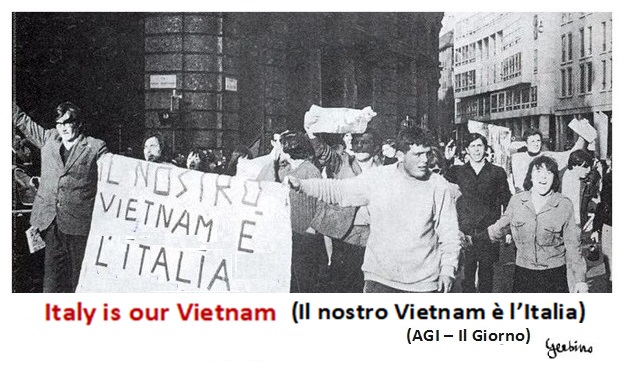
Italy is our Vietnam (Il nostro Vietnam è l'Italia).

















